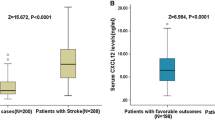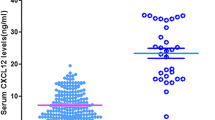Abstract
The aim of this study was to examine whether the circulating CXC chemokine ligand-12 (CXCL12) level can predict a 6-month outcome in Chinese patients with acute ischemic stroke (AIS). In a prospective study, CXCL12 levels were measured on admission in the serum of 304 consecutive patients with AIS. The prognostic value of CXCL12 to predict the functional outcome and mortality within 1 year was compared with the National Institutes of Health Stroke Scale score and with other known outcome predictors. A receiver operating characteristic (ROC) curve was used to evaluate the accuracy of serum CXCL12 in predicting functional outcome and mortality. Patients with an unfavorable outcome and non-survivors had significantly increased CXCL12 levels on admission (P < 0.0001 and P < 0.0001). Multivariate logistic regression analysis adjusted for common risk factors showed that CXCL12 (≥12.4 ng/mL; third quartile) was an independent predictor of functional outcome (odds ratio [OR] = 8.81; 95 % confidence interval [CI] 4.92–24.79) and mortality (OR = 10.15; 95 %CI 2.44–27.98). The area under the receiver operating characteristic curve of CXCL12 was 0.84 (95 % CI 0.76–0.92) for functional outcome and 0.87 (95 % CI 0.80–0.93) for mortality. Circulating CXCL12 serum levels at admission is a useful and complementary biomarker to predict functional outcome and mortality 6 months after acute ischemic stroke.




Similar content being viewed by others
References
Bonita R, Mendis S, Truelsen T et al (2004) The global stroke initiative. Lancet Neurol 3:391–393
Song FY, Wu MH, Zhu LH et al (2015) Elevated serum mannose-binding lectin levels are associated with poor outcome after acute ischemic stroke in patients with type 2 diabetes. Mol Neurobiol 52(3):1330–1340
Zhang JL, Yin CH, Zhang Y et al (2013) Plasma copeptin and long term outcomes in acute ischemic stroke. Acta Neurol Scand 128:372–380
Iwamoto T, Okamoto H, Toyama Y et al (2008) Molecular aspects of rheumatoid arthritis: chemokines in the joints of patients. FEBS J 275:4448–4455
Schutt RC, Burdick MD, Strieter RM et al (2012) Plasma CXCL12 levels as a predictor of future stroke. Stroke 43:3382–3386
Nagasawa T (2014) CXC chemokine ligand 12 (CXCL12) and its receptor CXCR4. J Mol Med 92:433–439
Xu Q, Sun XC, Shang XP, Jiang HS (2012) Association of CXCL12 levels in synovial fluid with the radiographic severity of knee osteoarthritis. J Investig Med 60:898–901
Camnitz W, Burdick MD, Strieter RM et al (2012) Dose-dependent effect of statin therapy on circulating CXCL12 levels in patients with hyperlipidemia. Clin Transl Med 1:1–5
Karouzakis E, Rengel Y, Jüngel A et al (2011) DNA methylation regulates the expression of CXCL12 in rheumatoid arthritis synovial fibroblasts. Genes Immun 12:643–652
Domanska UM, Kruizinga RC, Nagengast WB et al (2013) A review on CXCR4/CXCL12 axis in oncology: no place to hide. Eur J Cancer 49:219–230
van den Berk LCJ, van der Veer A, Willemse ME et al (2013) Disturbed CXCR4/CXCL12 axis in pediatric precursor B-cell acute lymphoblastic leukemia. Blood 122:2643–2643
Saiman Y, Jiao JJ, Fiel MI et al (2015) Inhibition of the CXCL12/CXCR4 chemokine axis with AMD3100, a CXCR4 small molecule inhibitor, worsens murine hepatic injury. Hepatol Res 45:794–803
Negrete-García MC, Velazquez JR, Popoca-Coyotl A et al (2010) Chemokine (CXC motif) ligand 12/stromal cell-derived factor-1 is associated with leukocyte recruitment in asthma. CHEST J 138:100–106
Li M, Hale JS, Rich JN et al (2012) Chemokine CXCL12 in neurodegenerative diseases: an SOS signal for stem cell-based repair. Trends Neurosci 35:619–628
Van Der Vorst E, Doering Y, Weber C (2015) MIF and CXCL12 in cardiovascular diseases: functional differences and similarities. Frontiers Immunol 6:373
Robin AM, Zhang ZG, Wang L, Zhang RL, Katakowski M, Zhang L et al (2006) Stromal cell-derived factor 1alpha mediates neural progenitor cell motility after focal cerebral ischemia. J Cereb Blood Flow Metab 26:125–134
Yu X, Chen D, Zhang Y, Wu X, Huang Z, Zhou H et al (2012) Over-expression of CXCR4 in mesenchymal stem cells promotes migration, neuroprotection and angiogenesis in a rat model of stroke. J Neurol Sci 316:141–149
Wurster T, Stellos K, Geisler T, Seizer P, Andia ME, Schuster A et al (2012) Expression of stromal-cell-derived factor-1 (SDF-1): a predictor of ischaemic stroke? Eur J Neurol 19:395–401
Ruscher K, Kuric E, Liu Y et al (2013) Inhibition of CXCL12 signaling attenuates the postischemic immune response and improves functional recovery after stroke. J Cereb Blood Flow Metab 33:1225–1234
Hatano S (1976) Experience from a multicentre stroke register: a preliminary report. Bull World Health Organ 54:541–553
Brott T, Adams HP Jr, Olinger CP et al (1989) Measurements of acute cerebral infarction: a clinical examination scale. Stroke 20:864–870
Adams HP, Bendixen BH, Kappelle LJ et al (1993) Classification of subtype of acute ischemic stroke. Definitions for use in a multicenter clinical trial. TOAST. Trial of Org 10172 in Acute Stroke Treatment. Stroke 24:35–41
Bamford J, Sandercock P, Dennis M et al (1991) Classification and natural history of clinically identifiable subtypes of cerebral infarction. Lancet 337:1521–1526
Sims JR, Gharai LR, Schaefer PW, Vangel M, Rosenthal ES (2009) ABC/2 for rapid clinical estimate of infarct, perfusion, and mismatch volumes. Neurology 72:2104–2110
Zhang ZG, Wang C, Wang J, Zhang Z et al (2015) Prognostic value of mannose-binding lectin: 90-day outcome in patients with acute ischemic stroke. Mol Neurobiol 51:230–239
Guo Y, Apostalakis S, Blann AD, Lip GY (2014) Plasma CX3CL1 levels and long term outcomes of patients with atrial fibrillation: the West Birmingham Atrial Fibrillation Project. Cerebrovasc Dis 38:204–211
Gu XL, Liu L, Lu XD et al (2015) Serum CXCL12 levels as a novel predictor of future stroke recurrence in patients with acute ischemic stroke. Mol Neurobiol. doi:10.1007/s12035-015-9151-0
Mehta NN, Matthews G, Krishnamoorthy P et al (2012) Higher plasma CXCL12 levels predict incident cardiovascular disease events: findings from the Chronic Renal Insufficiency Cohort Study. Circulation 126(21 Supplement), A13352
Kim YS, Baek W, Kim K et al (2012) Association between serum stromal cell-derived factor-1α and long-term outcome of acute ischemic stroke. Eur Neurol 67:363–369
Kwon HS, Kim YS, Park HH et al (2015) Increased VEGF and decreased SDF-1α in patients with silent brain infarction are associated with better prognosis after first-ever acute lacunar stroke. J Stroke Cerebrovasc Dis 24:704–710
Duan XX, Zhang GP, Wang XB et al (2015) The diagnostic and prognostic value of serum CXCL12 levels in patients with ischemic stroke. Neurol Sci 36:2227–2234
Navarro-Sobrino M, Rosell A, Hernandez-Guillamon M et al (2011) A large screening of angiogenesis biomarkers and their association with neurological outcome after ischemic stroke. Atherosclerosis 216:205–211
Liu P, Xiang JW, Jin SX (2015) Serum CXCL12 levels are associated with stroke severity and lesion volumes in stroke patients. Neurol Res 37:853–858
Bogoslovsky T, Spatz M, Chaudhry A, Maric D, Luby M, Frank J et al (2011) Stromal-derived factor-1α correlates with circulating endothelial progenitor cells and with acute lesion volume in stroke patients. Stroke 42:618–625
Wang Y, Huang J, Li Y et al (2012) Roles of chemokine CXCL12 and its receptors in ischemic stroke. Curr Drug Targets 13:166–172
Petit I, Jin D, Rafii S (2007) The SDF-1-CXCR4 signaling pathway: a molecular hub modulating neo-angiogenesis. Trends Immunol 28:299–307
Emsley HC, Tyrrell PJ (2002) Inflammation and infection in clinical stroke. J Cereb Blood Flow Metab 22:1399–1419
Li M, Ransohoff RM (2008) Multiple roles of chemokine CXCL12 in the central nervous system: a migration from immunology to neurobiology. Prog Neurobiol 84:116–131
Zernecke A, Bot I, Djalali-Talab Y et al (2008) Protective role of CXC receptor 4/CXC ligand 12 unveils the importance of neutrophils in atherosclerosis. Circ Res 102:209–217
van der Vorst EP, Döring Y, Weber C. (2015) Chemokines and their receptors in atherosclerosis. J Mol Med (Berl); Jul 15, DOI: 10.1007/s00109-015-1317-8.
Patel JR, McCandless EE, Dorsey D et al (2010) CXCR4 promotes differentiation of oligodendrocyte progenitors and remyelination. Proc Natl Acad Sci U S A 107:11062–11067
Mirabelli-Badenier M, Braunersreuther V, Viviani GL et al (2011) CC and CXC chemokines are pivotal mediators of cerebral injury in ischaemic stroke. Thromb Haemost 105(3):409
Schönemeier B, Schulz S, Hoellt V et al (2008) Enhanced expression of the CXCl12/SDF-1 chemokine receptor CXCR7 after cerebral ischemia in the rat brain. J Neuroimmunol 198:39–45
Ardelt AA, Bhattacharyya BJ, Belmadani A et al (2013) Stromal derived growth factor-1 (CXCL12) modulates synaptic transmission to immature neurons during post-ischemic cerebral repair. Exp Neurol 248:246–253
Acknowledgments
This study was supported by the National Natural Science Foundation of China (81371438). The funding plays no role in the study. We are grateful to the department of neurology and emergency department; the nurses, physicians, and patients who participated in our study; and the staff of the central laboratory of the hospital.
Author information
Authors and Affiliations
Corresponding author
Ethics declarations
Conflict of Interest
The authors declare that they have no competing interests.
Statement of Human Rights
The study was approved by the ethics committee of the First Affiliated Hospital of Zhengzhou University. The patients or their relatives gave written informed consent prior to entering the study.
Funding
This study was supported by the National Natural Science Foundation of China (81371438).
Rights and permissions
About this article
Cite this article
Cheng, X., Lian, YJ., Ma, YQ. et al. Elevated Serum Levels of CXC Chemokine Ligand-12 Are Associated with Unfavorable Functional Outcome and Mortality at 6-Month Follow-up in Chinese Patients with Acute Ischemic Stroke. Mol Neurobiol 54, 895–903 (2017). https://doi.org/10.1007/s12035-015-9645-9
Received:
Accepted:
Published:
Issue Date:
DOI: https://doi.org/10.1007/s12035-015-9645-9




